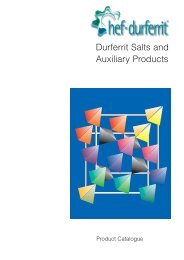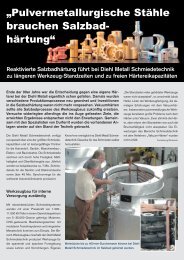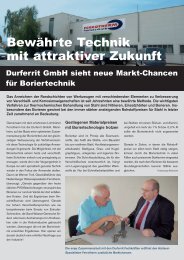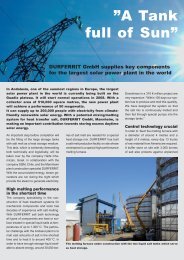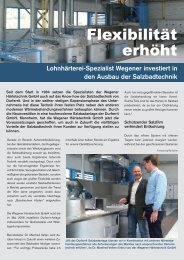TUFFTRIDE®-/QPQ®-PROCESS - Durferrit
TUFFTRIDE®-/QPQ®-PROCESS - Durferrit
TUFFTRIDE®-/QPQ®-PROCESS - Durferrit
You also want an ePaper? Increase the reach of your titles
YUMPU automatically turns print PDFs into web optimized ePapers that Google loves.
Fig. 18<br />
Fig. 19<br />
Fig. 20<br />
Fig. 18 shows gas springs and QPQ ® treated piston<br />
rods. These parts are mainly built into tailgate flaps<br />
and engine bonnets of cars, as well as into the baggage<br />
flaps and cabin doors of aeroplanes.<br />
It is reported that, compared with the hard chrome<br />
plating previously carried out, the corrosion and wear<br />
resistance is considerably improved. Furthermore, the<br />
cost of treating these parts was reduced by about<br />
one third.<br />
Fig. 19 shows small parts such as fastenings for suitcases<br />
and hairdryer grilles. These parts are treated in<br />
bulk and in very large quantities by the QPQ ® process.<br />
A nitrocarburizing duration of 60 minutes plus oxidative<br />
cooling, vibratory polishing and oxidative post<br />
treatment are enough to obtain the required corrosion<br />
and wear resistance.<br />
Representing the greatly diversified applications of the<br />
QPQ ® process are the typical components in Fig 20,<br />
which are nowadays treated in large quantities<br />
TUFFTRIDE ® resp. Most of the parts involved, for<br />
example windscreen-wiper shafts, v-belt tighteners<br />
and valves, are used in the automotive industry.<br />
The QPQ ® process is also used for components in the<br />
aircraft, motocycle and utility vehicle industry, in offshore<br />
technology, in the construction of plant and<br />
machinery, in energy technology, in the food industry<br />
as well as in the manufacture of textile machines,<br />
hydraulic aggregates and optical equipment.<br />
13



